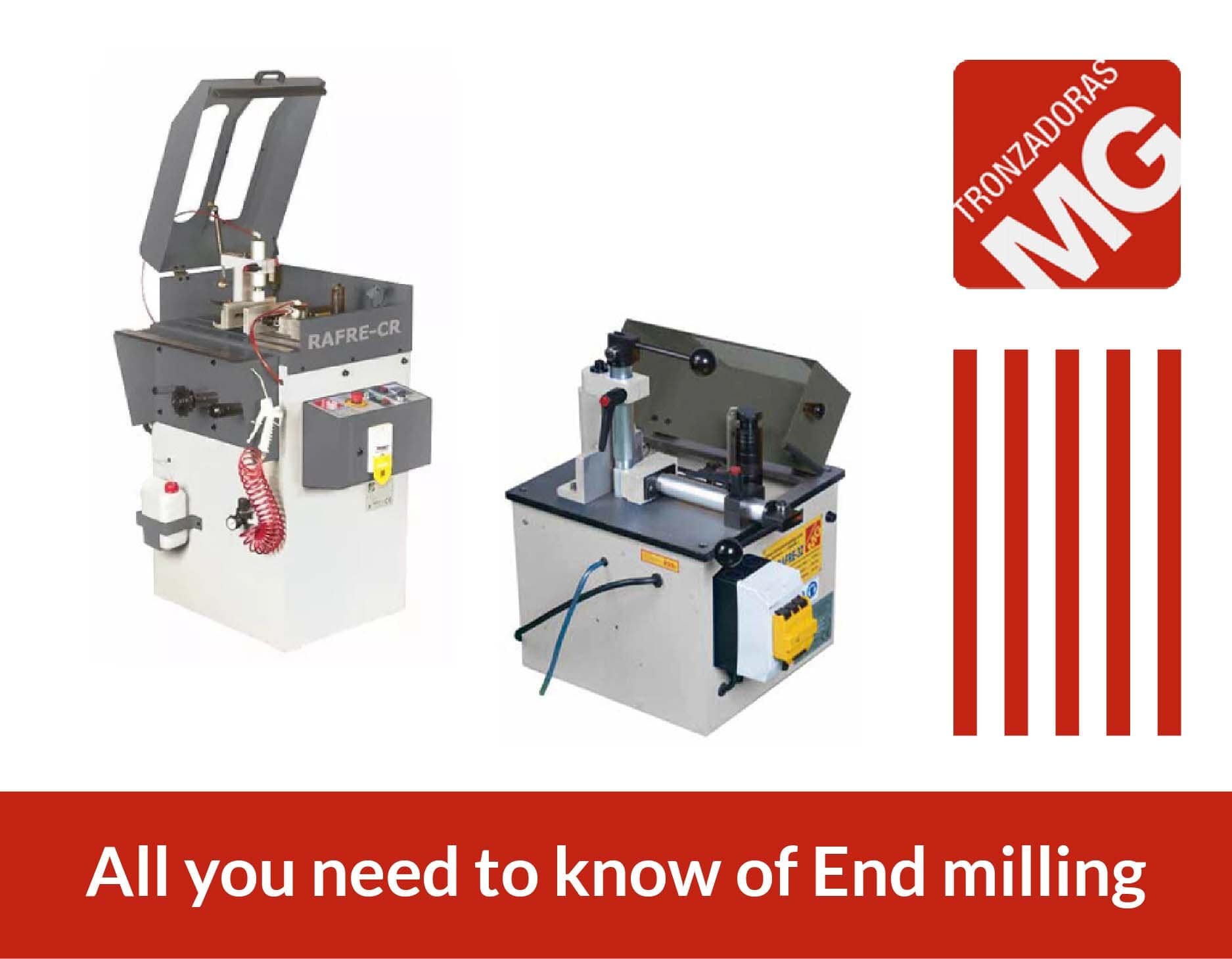
What is an End Milling Process?
An end milling process consists of a cylindrical cutter that permits end cutting and peripheral cutting, this cylindrical cutter has multiple cutting edges on both its periphery and its tip. To reduce the impact that occurs when each flute engages the workpiece, these cutting edges or flutes are usually made helical.
Milling cutters are cutting tools typically used to perform milling operations and occasionally in other machine tools in milling machines or machining centers. A milling cutter’s cylindrical shank has cutting teeth on the end and usually spiral blades on the lateral surface. End milling is one of the milling cutters.
In industrial fabrication applications, end milling is a practical and very common procedure of a physical surface preparation process used to generate material chips by feeding a metal workpiece into a revolving cutter. It is used for milling applications such as profile milling, tracer milling, face milling, plunging, contouring, slotting, drilling, and reaming.
The main specialty of an end milling cutter is that it can cut in all directions, while a drill can only cut in the axial direction. Some of the Popular end mill designs include Roughing End Mills, Finishing End Mills, Square End Mills, Ball End Mills, and Corner Rounding End Mills.
The end milling machine is suitable for the end face milling of aluminum materials and has a large processing range. This aluminum end milling machine is widely used in the machinery manufacturing industry.
End milling is facilitated by several axial directional cutting that is typical of drill bits. Depending on the intended purpose of the mill and the properties of the metal to be treated, their specifications can vary.
How End Mills Are Categorized?
They are categorized on the basis of;
- Type of tools that are affixed to them
- The number of flutes
- The helix angle
- The compositional material
- The coating material
Standard Coatings/Finishes:
Protective coatings, such as titanium nitride, increase tool efficiency by reducing or eliminating the need for lubrication because the coating prevents aluminum from adhering to the tool. Now let's discuss types of coating.
-
Titanium Carbonitride (TiCN)
Compared to Titanium Nitride (TiN), it is harder, more wear-resistant, and provides the ability to run applications at higher spindle speeds, which is commonly used on stainless steel, cast iron, and aluminum alloys. There is a tendency to gall, so use caution on nonferrous materials, and requires an increase of 75-100% in machining speeds vs. uncoated tools.
-
Titanium Nitride (TiN)
It is a general-purpose coating used to coat softer materials, by providing high lubricity and increasing chip flow. In machining speeds vs. uncoated tools, the heat and hardness resistance allows the tool to run at higher speeds of 25% to 30%.
-
Aluminum Titanium Nitride (AlTiN)
The Aluminum Titanium Nitride is considered one of the most abrasive-resistant and hardest coatings, which is commonly used for machining aircraft and aerospace materials, nickel alloy, stainless steel, titanium, cast iron, and carbon steel.
-
Zirconium Nitride (ZrN)
Zirconium Nitride is almost similar to Titanium Nitride (TiN ), but has a higher oxidation temperature and resists sticking, and prevents edge build-up, which is commonly used on nonferrous materials including aluminum, brass, copper, and titanium.
-
Titanium Aluminum Nitride (TiAlN)
It has a higher hardness and oxidation temperature and is ideal for stainless steel, high alloy carbon steels, nickel-based high-temperature alloys, and titanium alloys. And for this also there is a tendency to gall, so use caution on nonferrous materials, and requires an increase of 75-100% in machining speeds vs. uncoated tools.
Features And Specifications Of End Mill
Types
-
Ordinary flute
It is also called Regular flute and is most commonly used for roughing and finishing side milling, slotting, and shoulder milling.
-
Tampered flute
A tapered flute is used for special applications Like mould drafts and for applying taper angles after conventional straight-edged milling.
-
Roughing flute
Roughing type has a wave-like edge form and these are made to break the material into small chips. Additionally, since the cutting resistance is low it enables high feed rates when roughing. For regrinding, the inside face of the flute will be more suitable.
-
Formed flute
The formed flute is geometrically designed for producing corner radius on components. There are an infinite number of different geometries that can be manufactured using different styles of cutters.
Type of End Cutting Edge
-
Square ends with a center hole
This kind of cutting edge is generally used for side milling, slotting, and shoulder milling. The Center hole is used to ensure accurate grinding and regrinding of the tool, due to that plunge cutting is not possible
-
Square end with a center cut
These kinds of cutting edges are generally meant for side milling, slotting, and shoulder milling. Plunge cutting is possible and when fewer flutes are used then greater plunge cutting efficiency is obtained. In addition to this regrinding on the flank face can be done.
-
Ball end
Ball ends are geometrically designed to be completely suited for curved surface milling. At the extreme endpoint, a very small chip pocket can lead to an inefficient chip
-
Corner radius end
The Corner radius end is used for radius profiling and corner radius milling. While you picking feed milling an end mill with a large diameter and small corner radius can be used efficiently.
Type of Shank And Neck Parts
-
Standard or straight shank
The Standard or straight shank is the most widely used type.
-
Long shank
The long shank type is designed for deep pocket and shoulder applications.
-
Long neck
The long neck type is geometrically designed to be used for deep slotting and is also suitable for boring.
-
Taper neck
The long taper neck type features are best utilized on deep slotting and mould draft applications.
Cutting Tool Materials
-
Carbide-Tips
They are brazed to the cutting edge of steel tool bodies. They cut faster than high-speed steel. Ferrous and nonferrous materials including cast iron, steel, and steel alloys are its main scope of areas. It is mainly used for larger-diameter tools, as it can reduce costs.
-
High-Speed Steel (HSS)
Compared to cobalt or carbide end mills, High-Speed Steel provides good wear resistance and fewer costs and is used for general-purpose milling of both ferrous, and nonferrous materials.
-
Cobalt (M-42: 8% Cobalt):
Compared to HSS, cobalt provides better wear resistance, higher hot hardness, and toughness. Using Cobalt will give you chances of very little chipping or microchipping under severe cutting conditions, allowing the tool to run 10% faster than HSS, resulting in excellent metal removal rates and good finishes. Ideal for machining cast iron, steel, and titanium alloys as it is considered a cost-effective material.
-
Vanadium High-Speed Steel (HSSE)
It is designed to increase abrasive wear resistance and toughness and is made of high-speed steel, carbon, vanadium carbide, and other alloys. And which are used for general applications on stainless steel and high silicon aluminum.
-
Solid Carbide
It provides better rigidity and can run 2-3X faster than high-speed steel (HSS) and is extremely heat resistant. It is used on cast iron, nonferrous materials, plastics, and other tough-to-machine materials for high-speed applications. However, heavy feed rates are less suitable for solid carbide.
-
Powdered Metal (PM)
Compared to solid carbide powdered metal is tougher, more cost-effective and also it is less prone to breakage. PM is used in high-shock and high-stock applications such as roughing and it performs well in materials < 30RC.
-
Polycrystalline Diamond (PCD)
It is a shock-resistant and wear-resistant synthetic diamond that allows for cutting at high speeds on nonferrous materials, plastics, and extremely difficult-to-machine alloys.
How To Choose The Right End Mill?
Now let’s discuss how we can choose the right End Mill for our work.
-
End Mill Length
First, decide the depth that your end mill must cut and then choose the shortest length end mill that can still make the cut. Because choosing the shortest length greatly increases the stability of the tool. While reducing the tendency for the tool to chatter this will allow for more aggressive feeds and speeds.
2.End Mill Materials
High-speed steel (HSS) and carbide are the two most common materials used in the manufacturing of end mills. HSS is really expensive, runs slower, and is useful in older, slower, or less rigid machines as well as in one-off or very short-run production. It is also less brittle and more forgiving of unstable conditions.
Carbide runs with higher speed, fewer tooling changes, and increased productivity so it is highly preferred in CNC machine tools. In these applications, because of its durability and higher efficiency, it’s justifiable for its high cost.
3.Flute Count
Helical grooves that wrap around the sides of an end mill are flutes. A smaller number of flutes (2-3 flute tools) will offer more flute space for long chipping materials such as aluminum, even 2-3 flute tools will offer more flute space and a larger number of flutes reduces the flute space. But a larger number of flutes can offer increased productivity in shorter chipping materials such as medium to high carbon steel and iron.
Stainless steel, high temp alloys, and iron, a four-flute endmill is preferred for slotting applications and can be a great general-purpose tool in the case of steel. For applications with a low radial depth of cut to allow for chip evacuation, higher flute counts should be reserved.
4.End Geometry
Choosing the right end mill geometry is playing a vital role in the tool’s success. Paying close attention to the materials that the manufacturer recommends for a given tool, and the speeds and feeds the manufacturer recommends for that material are important things to ensure your success.
5.End Mill Coatings
To reduce friction and protect the carbide from the heat that is generated in cutting, a coating is necessary. Selecting the suitable coating is a big task as only some coatings are suitable for certain materials. For this, it's better to pay attention to the manufacturer’s recommendations to make sure you are using the correct coating.
6.Tool Life
Tools are justifiably expensive. It’s critical to invest in the right tooling that can keep up with the volume of work if you have high production and heavy workloads. Choosing second-quality tooling costs time and money on wasted material, scrap, wasted tool spend, and added wear and tear on your CNC machines.
Even though there are many End milling cutter manufacturers but selecting the best cutter is a big task. For a better outcome, the end milling cutter should be precise. At Tronzadoras MG, you will get all solutions related to cutting machines..
We can provide you wide range of end mills designed to give you an edge over the competition. If you have any doubts or queries about end milling machines please feel free to contact us.










